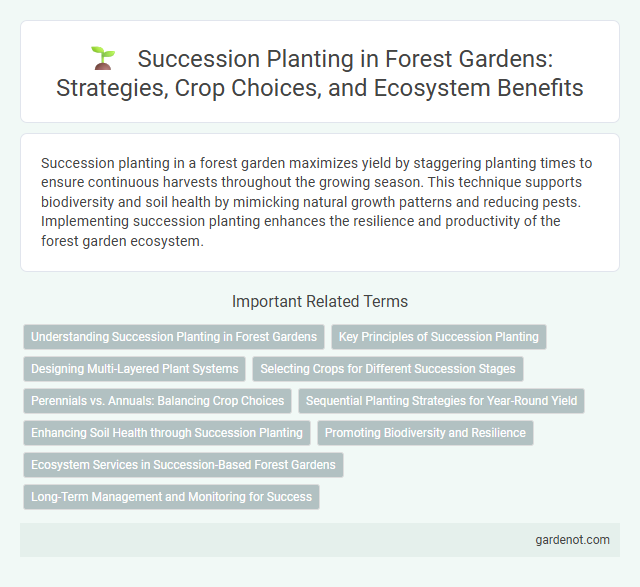Succession planting in a forest garden maximizes yield by staggering planting times to ensure continuous harvests throughout the growing season. This technique supports biodiversity and soil health by mimicking natural growth patterns and reducing pests. Implementing succession planting enhances the resilience and productivity of the forest garden ecosystem.
Understanding Succession Planting in Forest Gardens
Succession planting in forest gardens ensures continuous harvest by strategically planting crops at intervals to maximize space and nutrient usage. This technique mimics natural forest ecosystems, where species layer and mature over time, enhancing biodiversity and resilience. Proper understanding of succession planting helps optimize plant growth cycles and supports a sustainable, productive forest garden.
Key Principles of Succession Planting
Succession planting in forest gardens maximizes productivity by staggering crop cycles and ensuring continuous harvests throughout the growing season. Key principles include selecting compatible plant species based on their growth habits and nutrient needs, timing plantings to match seasonal conditions, and maintaining soil health to support successive crops. This method enhances biodiversity, reduces pest pressures, and improves overall garden resilience.
Designing Multi-Layered Plant Systems
Succession planting enhances forest garden productivity by strategically arranging multi-layered plant systems, mimicking natural forest succession patterns. Incorporating a diverse range of canopy, understory, shrub, herbaceous, and ground cover species ensures continuous harvests and ecosystem resilience. Designing these layers to support nutrient cycling and mutualistic relationships optimizes space and resource use over time.
Selecting Crops for Different Succession Stages
Selecting crops for different succession stages in a forest garden involves planting pioneer species such as nitrogen-fixing legumes in the early stage to improve soil fertility and create shade. Mid-succession crops like shade-tolerant vegetables and perennial herbs thrive once the canopy begins to develop, optimizing resource use. Late succession plants, including fruit trees and understory shrubs, complete the ecosystem by establishing long-term productivity and biodiversity.
Perennials vs. Annuals: Balancing Crop Choices
Succession planting in forest gardens benefits from balancing perennials and annuals to maximize yield and soil health. Perennials like berries and herbs establish deep root systems that stabilize soil and improve nutrient cycling, while annuals such as legumes and leafy greens provide quick harvests and enrich the soil through nitrogen fixation. Strategic integration of these crops ensures continuous productivity and long-term ecological resilience.
Sequential Planting Strategies for Year-Round Yield
Succession planting in forest gardens involves strategically staggering the planting times of different crops to ensure continuous harvest throughout the year. Utilizing fast-maturing species alongside slower-growing perennials maximizes space and resources, promoting diverse yields across seasons. Implementing this sequential planting strategy enhances soil health and ecosystem resilience while sustaining consistent food production.
Enhancing Soil Health through Succession Planting
Succession planting in forest gardens accelerates nutrient cycling by introducing diverse plant species that enrich soil organic matter and promote microbial diversity. Deep-rooted perennials access and redistribute nutrients from subsoil layers, while nitrogen-fixing plants increase soil fertility by naturally adding essential nutrients. This strategic layering and timing of plants optimize soil structure, reduce erosion, and enhance overall ecosystem resilience for sustained garden productivity.
Promoting Biodiversity and Resilience
Succession planting in forest gardens enhances biodiversity by continuously introducing diverse plant species that occupy different ecological niches throughout the growing season. This method supports ecosystem resilience by maintaining soil health, reducing pest outbreaks, and providing continuous habitat and food sources for beneficial insects and wildlife. Implementing successive plantings ensures a dynamic, self-sustaining garden system that adapts to environmental changes and maximizes productivity.
Ecosystem Services in Succession-Based Forest Gardens
Succession planting in forest gardens enhances ecosystem services by promoting biodiversity through layered vegetation that supports pollinators, soil microbes, and wildlife habitats. This natural progression improves nutrient cycling, soil fertility, and water retention, creating resilient microclimates that boost plant growth and carbon sequestration. Incorporating pioneer and climax species in succession-based forest gardens fosters continuous canopy cover and ecosystem stability over time.
Long-Term Management and Monitoring for Success
Succession planting in a forest garden requires long-term management strategies that include regular monitoring of plant growth, soil health, and biodiversity to ensure sustainable productivity and ecosystem balance. Implementing a dynamic planting schedule adapts to changes in microclimate and nutrient availability, promoting continuous harvests and minimizing gaps in vegetation cover. Consistent observation and record-keeping support timely interventions such as pruning, replanting, or adjusting species composition for optimal forest garden resilience.
Succession planting Infographic

 gardenot.com
gardenot.com